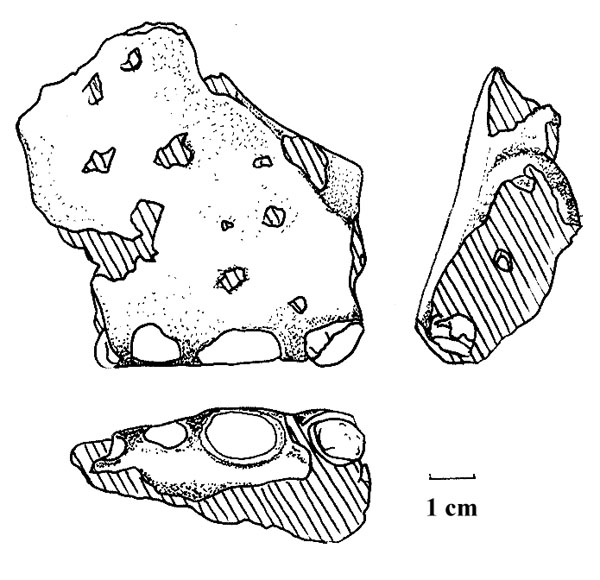
Genus: Nicorhynchus HOLGADO & PEGAS, 2020
Etymology: Old English, nicor, "knuckel (a kind of water dragon)" and Greek, rhughkos, Latinized as rhynchus, "snout." In reference to the fact that the new taxon represents a piscivorous flying reptile from marine and fluvial deposits, represented by fragmentary snouts.
= Genus nova RODRIGUES & KELLNER, 2013
Species: capito (SEELEY, 1869) HOLGADO & PEGAS, 2020
Etymology: Latin, capio, “to catch.”
= Pterodactylus capito (SEELEY, 1869) SAUAGE, 1882
= Ptenodactylus capito SEELEY, 1869 (nomen
dubium)
= Ornithocheirus capito (SEELEY, 1869) SEELEY,
1870
= Coloborhynchus capito (SEELEY, 1869)
UWIN, 2001
Holotype: CASM B54.625
Locality: Cambridge, Cambridgeshire County, England, Southern United Kingdom.
Horizon: Upper Cambridge Greensand.
Biostratigraphy:
Age: Cenomanian Stage, Late Gallic Subepoch, Early Senonian Subepohc, Middle Cretaceous in Albian Stage, Middle Gallic Subepoch, Upper Early Cretaceous Epoch, Middle Cretaceous (as per HOLGADO & PEGAS, 2020).
Material: A fragment of premaxilla.

After Unwin, 2001
Referred material:
MARTILL & UNWIN, 2012
= Nicorhynchus cf. capito HOLGADO & PEGAS, 2020Locality: Cambridge, Cambridgeshire County, England, Southern United Kingdom.
Horizon: Upper Cambridge Greensand.
Biostratigraphy:
Age: Valanginian Stage, Neocomian Subepoch- Albian Stage, Middle Gallic Subepoch, Upper Early Cretaceous Epoch, Middle Cretaceous.
Material:
NHMUK R481: Fragment of rostrum.
= Ornithocheirus reedi SEELEY, 1870 (nomen dubium)
Etymology: In honor of William Harlow Reed.
= Criorhynchus reedi (SEELEY, 1870) OWEN, 1874 (nomen dubium)Holotype:?
Locality: Cambridge, Cambridgeshire County, England, Southern United Kingdom.
Horizon: Upper Cambridge Greensand.
Biostratigraphy:
Age: Cenomanian Stage, Late Gallic Subepoch, Early Senonian Subepohc, Middle Cretaceous in Albian Stage, Middle Gallic Subepoch, Upper Early Cretaceous Epoch, Middle Cretaceous (as per HOLGADO & PEGAS, 2020).
Material: Anterior part of premaxilla.
_____________________________________________________________________________________
Species: fluviferox (JACOBS, MARTILL, IBRAHIM, & LONGRICH, 2019) HOLGADO & PEGAS, 2020
= Coloborhynchus fluviferox JACOBS, MARTILL, IBRAHIM, & LONGRICH, 2019
Etymology: Latin, fluvi, "a river" and Latin, ferox "fierce." For a ferocious-looking pterosaur inhabiting a vast, ferocious river system (the Kem Kem river system was home to several giant predators such as Spinosaurus and Carcharodontosaurus).
Holotype: FSAC-KK 10701
Locality: Possibly Aferdou N-Chaft, Hassi El Begaa, Er Rachidia Province, South-eastern Morocco.
Horizon: Kem Kem Group, Ifezouane Formation.
Biostratigraphy:
Age: ?Albian Stage, Middle Gallic Subepoch, Late Early Cretaceous Epoch, Late Early Cretaceous-Lower Cenomanian Stage, Late Gallic Subepoch, Early Gulf Epoch, Middle Cretaceous.
Material: An anterior portio nof rostrum displaying alveoli from the 1st to 3rd pair of teeth.
Referred material:
FSAC-KK 5024/SMNK PAL 45833 (cast of a private specime):
_____________________________________________________________________________________
Species: smaugi HOLGADO & PEGAS, 2020 (nomen nudum)
Etymology:
Holotype:
Locality:
Horizon:
Biostratigraphy:
Age:
Material: